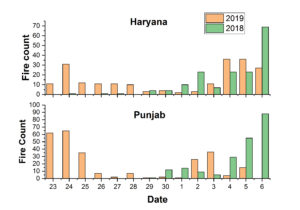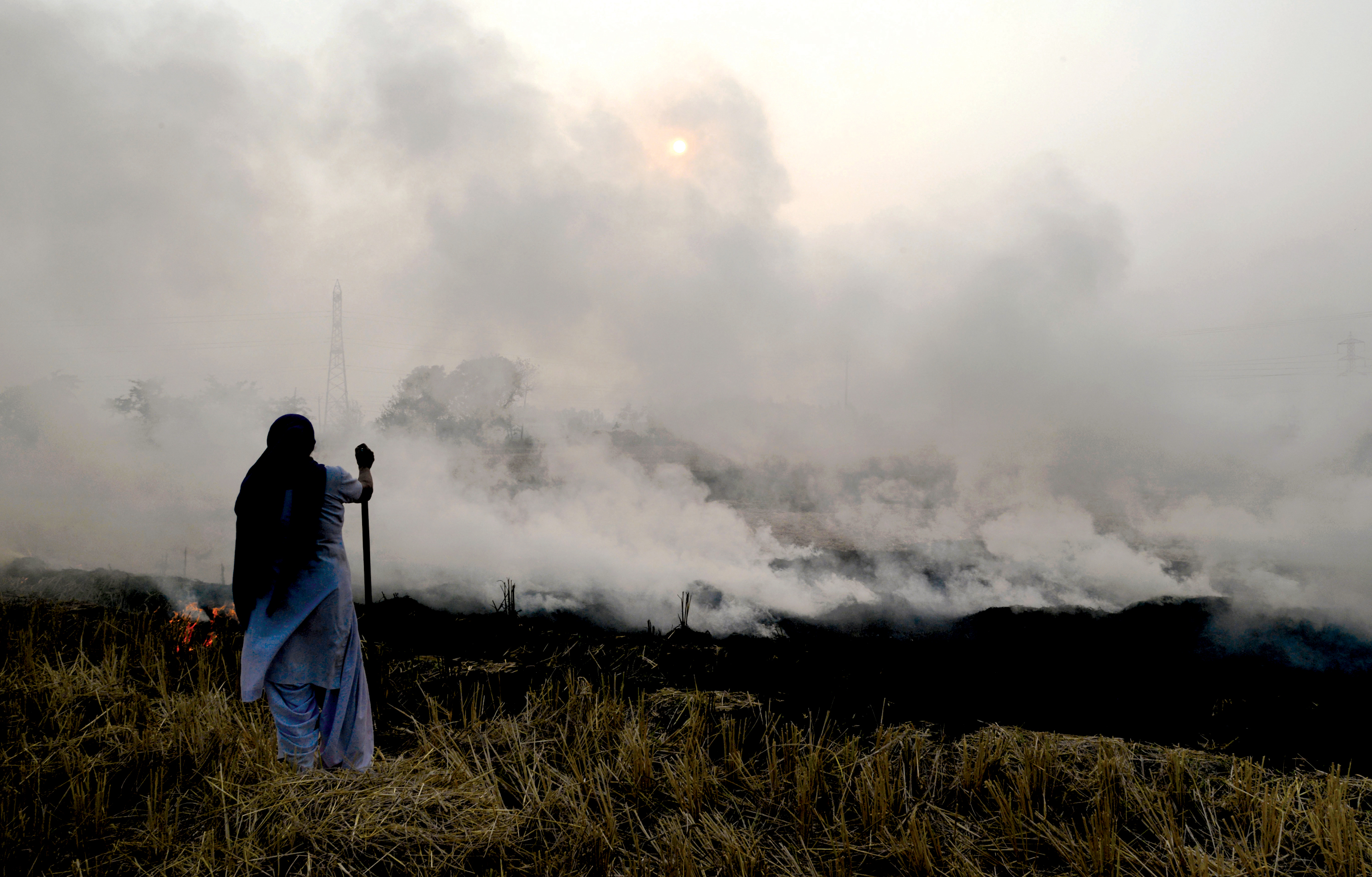Delhi’s citizens are sitting ducks as stubble is burnt in neighbouring states. Multiplicity of agencies also seems to be making solutions elusive
IIT Delhi has found that this year the stubble burning has started earlier than in previous years and that Punjab is a bigger culprit in this matter than Haryana.
Patriot met with Hemant Kaushal, who is the Project Coordinator for Centre of Excellence for Research on Clean Air (CERCA), a department started just last year in 2018 for countering the growing extreme levels of air pollution in Delhi. He pointed to two regions – Gurdaspur and Amritsar — and pointed out that stubble burning had in fact increased this year.
But what do we do with these numbers? Do they even shock us? Since the air started deteriorating in 2016, the Delhi government has pointed to the neighbouring regions but has been unable to mitigate the effects. This, of course, as it does not have jurisdiction over these states whose farmers are burning their stubble, which they find much cheaper than removing it.
So again, this year, Delhi’s residents must be prepared to suffer. The last few days have seen the air pollution levels of the Capital city deteriorate — just after Chief Minister Arvind Kejriwal boasted that air pollution dropped 25% in the past four years.

While walking around in the city or boarding the Metro, you can see people coughing and sneezing — a sign that respiratory illnesses are back.
Indian Council of Medical Research (ICMR) had said in a report that air pollution caused one in eight deaths in India last year.
In 2017, the mean ambient particulate matter PM2.5 annual exposure of 90 g/m3 was one of the highest in the world. The highest PM2.5 exposure level was in Delhi, followed by Uttar Pradesh, Bihar and Haryana. The report said 1.24 million deaths in India in 2017 were due to air pollution, which included 670,000 deaths due to outdoor particulate matter air pollution and 480,000 deaths due to household air pollution.
And if that doesn’t confirm the worst, the fact that New Delhi is the most polluted Capital city in the world should cement our worries firmly in the ground. Why then are we on a yearly basis losing the war with pollution? In 2017 November, CM Kejriwal had tweeted: “Delhi has become a gas chamber. Every year this happens during this part of year. We have to find a solution to crop burning in adjoining states” and yet no solution is in sight.
Crop burning from Haryana and Punjab has again proved to be the disease no one residing here can avoid.
The National Aeronautics and Space Administration (NASA) on its Fire Information for Resource Management System (FIRMS) website has released images of crop burning in India. The Delhi government shared the images and The System of Air Quality and Weather Forecasting and Research (SAFAR) also stated that it had noticed an increasing trend of stubble burning incidents around Delhi.
According to the website of Central pollution control board, the AQI level in Anand Vihar on Wednesday the 16th October 9 pm was at 342, marked as “very poor” with the “prominent pollutant” being PM 2.5. In Dwarka sector 8 the level is even higher at 361 AQI with the “prominent pollutant” being PM 10. While the pollution level at Siri Fort was also at “very poor” with the AQI levels at 332 and PM 2.5 being the “prominent pollutant” here.
The health effects from both these particulate matters include toxic effects by absorption of the toxic material into the blood (e.g. lead, cadmium, zinc); bacterial and fungal infections (from live organisms); fibrosis (e.g. asbestos, quartz); cancer (e.g. asbestos, chromates) and increased respiratory symptoms, aggravation of asthma and premature death.
In Kaushal’s office at IIT Delhi, the AQI was at 178 which comes under the Red Zone at 151-200, marked as ‘Unhealthy’.
While he is of the view that the war is not lost, there isn’t much good news as he goes on to say, “We haven’t lost the war but we aren’t prepared for it either” and that “It is a little late to start this war”.
So, his present solution and advise to the residents of Delhi is to wear masks. What the Delhi government on their part could do is raise awareness, which he thinks the distribution of 40 lakh masks by AAP government to students will do.
He also backs the odd-even formula for plying of cars even though it is a “short-term plan”. Incidentally, right after our conversation, the CM held a press conference where he announced the implementation of this plan from November 4 to 15.
There are some who will be exempted like vehicles, taking children to school, ones with patients, women, the cars of the PM and president amongst other officials but not CM Kejriwal or his Deputy, Manish Sisodia.
While these are some measures, what is important is that policies are properly implemented . “This Diwali, the pollution levels will not go higher than it already is if the complete ban is implemented”, Kaushal says, adding that while green crackers were introduced as an eco-friendly way to enjoy Diwali, these are nowhere to be found.
“Governments have political agenda”, which means their actions are governed by the call “for votes”. But the point here remains that unlike in other situations, air is something even the politicians are affected by, he adds. Checking that emission norms are being followed and the various bans on polluting sites and materials are being adhered to is thus critical to have any positive result for the air we breathe.
IIT Delhi’s solutions
Project coordinator of CERCA Hemant Kaushal shared a few things that the premium institute is doing:
gDeveloping an algorithm which will predict future emission levels. Through this, a week before air pollution goes to extremes the warnings will be given and authorities can take needed steps.
gStudy on best practices. IIT Delhi has completed its study in Japan with their next goal to see how China, Korea and then US and UK manage air pollution
gIIT Delhi start-up called Kriya Labs has developed a technology that converts agro-waste like rice straw into pulp, and process it into biodegradable cutlery. They want it now to go a step further and make paper with it
gAir quality censors in Delhi buses which will help pinpoint pollution hotspots
gChecking carbon footprint of IIT Delhi in partnership with NITI Aayog.
As the dust flies…
The NDMC has said that to tackle air pollution, they have water sprinklers and mechanised machines for sweeping of roads. NDMC has 24 water tankers with 9 kilolitre (KL) capacity for sprinkling water on roads before sweeping.
In addition, 104 vehicles mounted with water tankers of 900 litres of water are also present.
But the problem is they say, they don’t get enough funds. Which means, things like sanitation cannot be taken care of. NDMC Mayor Avtar Singh said that in 2018 while their demand was Rs 650 crores for sanitation, they received nothing. This year while their demand was Rs 675 crore, they were given Rs 200 crore.
But there may be more trouble as even the mechanised machines are a bone of contention here. A senior official who did not want to be named said that a case regarding tenders being awarded for the operation and maintenance of the machines has reached the Delhi High Court.
He said that the agency given the contract for NDMC charges a rate of Rs 16,000 per vehicle per day for 8 hours. EDMC on the other hand gets charged Rs 9,000 for the same amount of time and the SDMC “are running with their own resources and are not given a lump sum contract”.
“For the past two years, the mechanised cleaning system in the NDMC area was operating without any compliant order and Rs 7-8 crore has been spent”. And this “file has now been sent to the LG two days back”, the official added.
Unless the MCD clears up this financial mess, how will it clean up the city?





